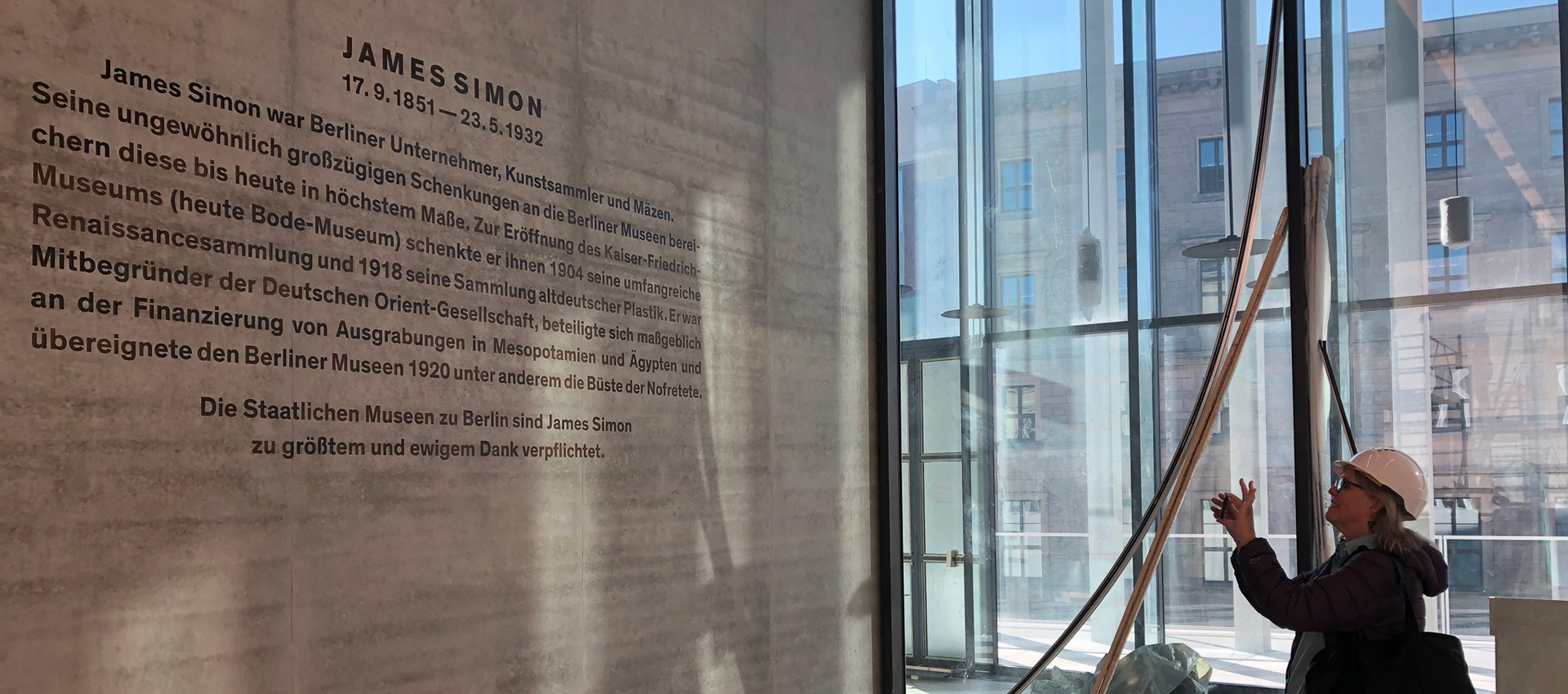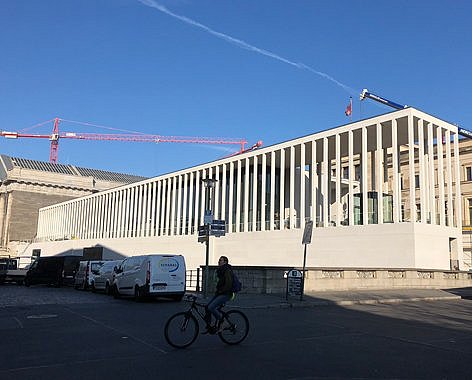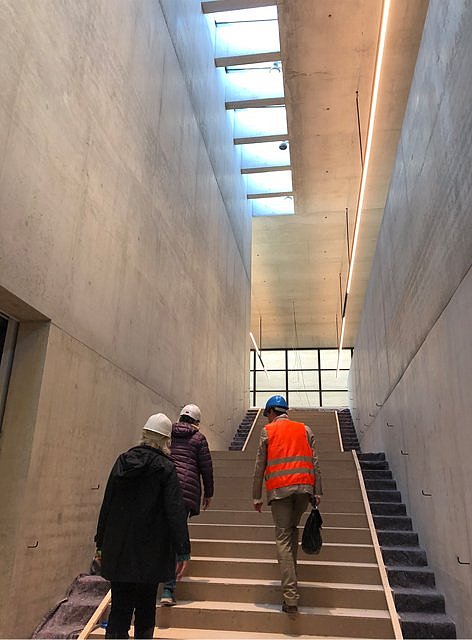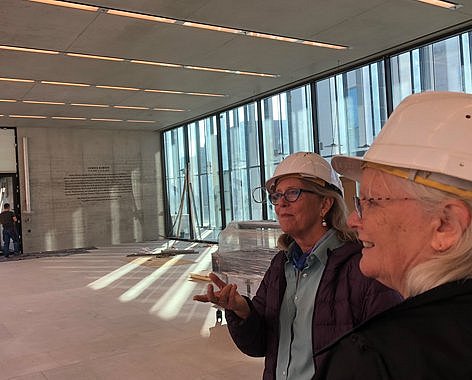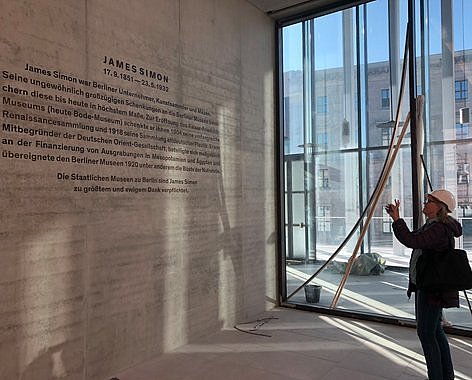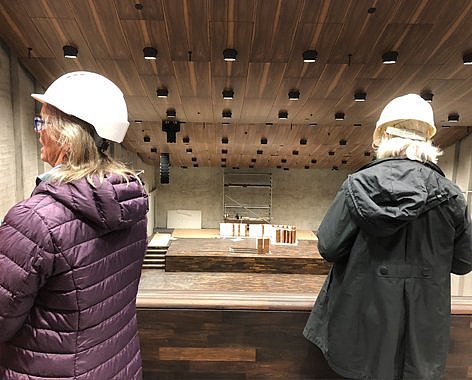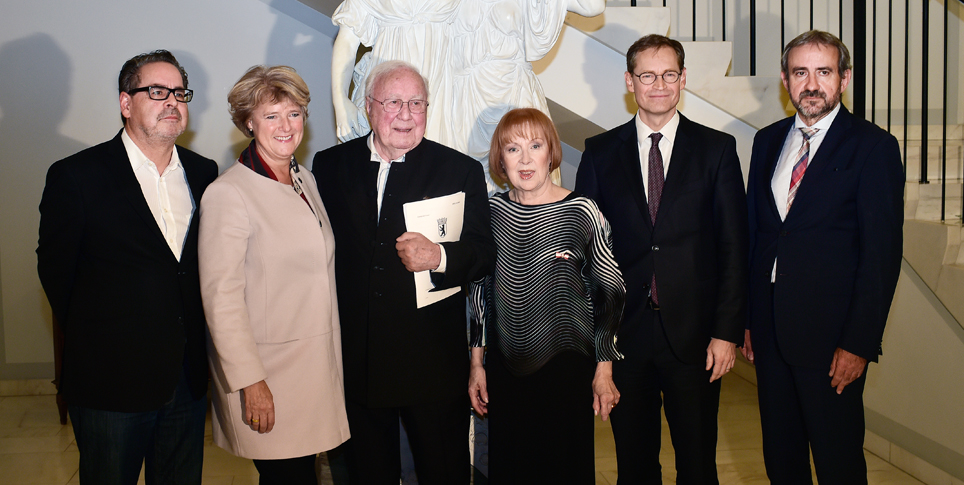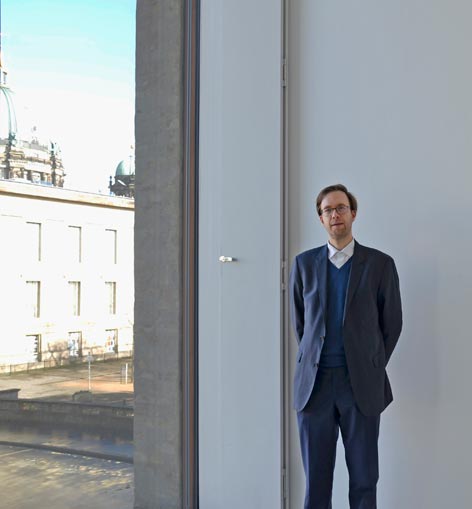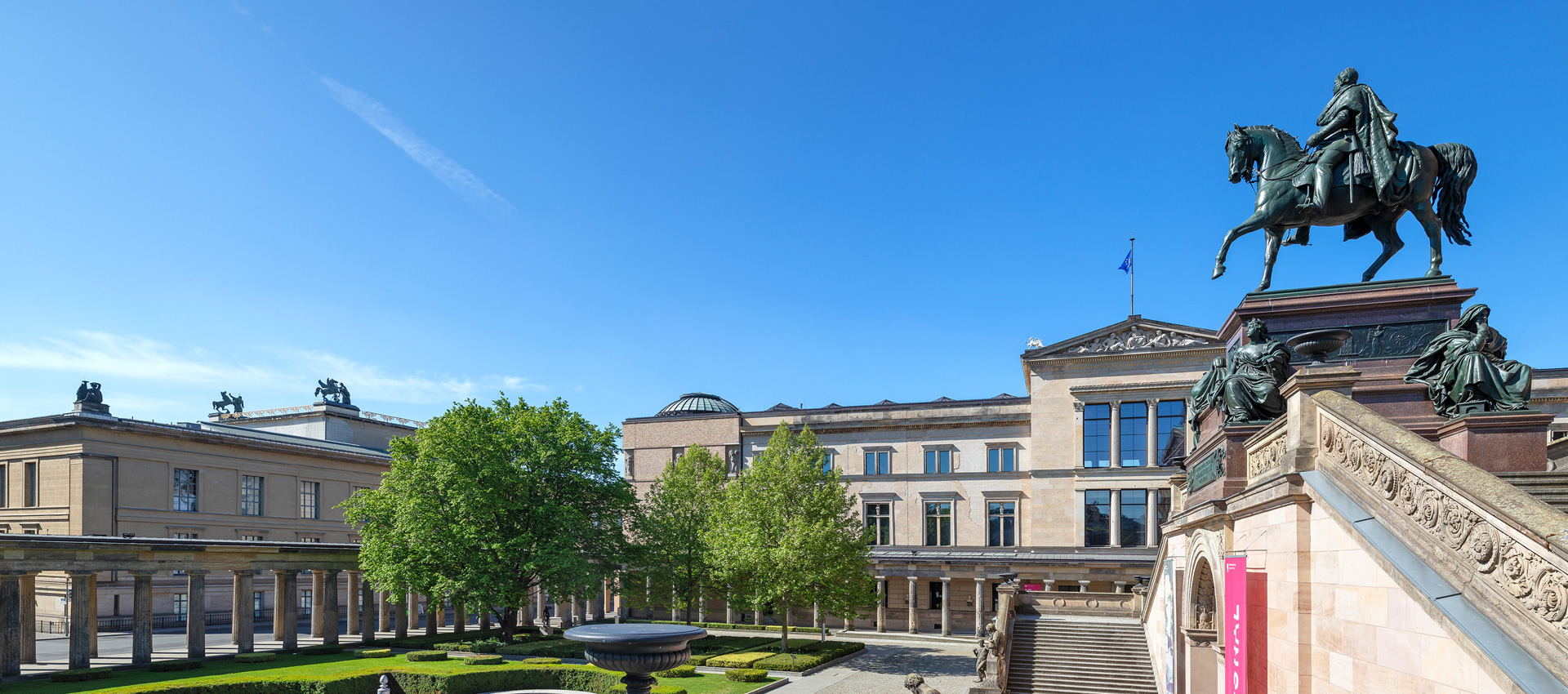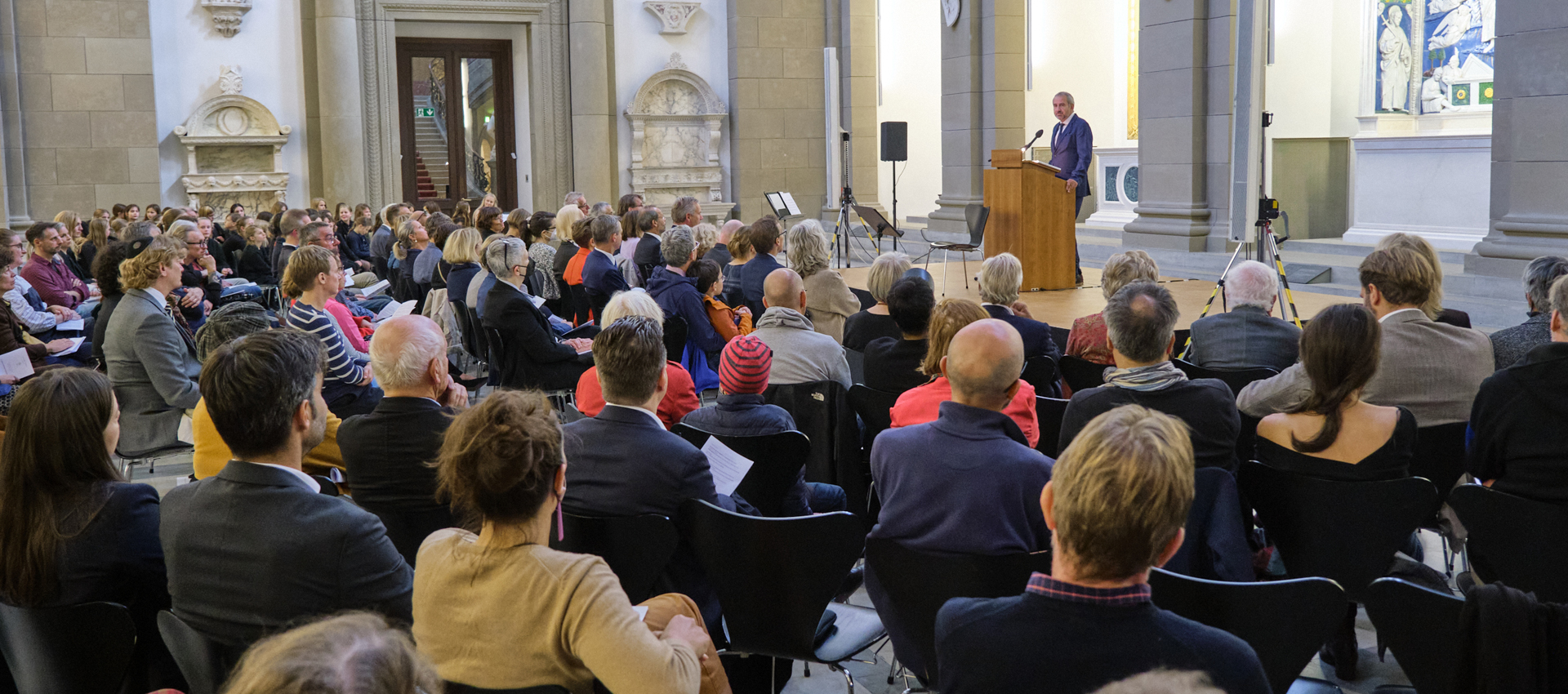The name of the man who Berlin has to thank for the bust of Nefertiti and much more has been all but forgotten. The new reception building on Museumsinsel (Museum Island) will change that. And Chris Simon, an American filmmaker, would like to restore her great-grandfather James’s story to memory in a film. We met Chris and her sister Pam in November 2018 for a tour of the construction site.
A Tuesday morning in November 2018, Germany, Berlin-Mitte, Museumsinsel. The two American women, Pam and Chris Simon, were a little excited. The James-Simon-Galerie was almost finished, and in a minute, they would enter the building for the first time. They put on safety helmets and then the tour started. They walked into the middle building of the David Chipperfield triad (Neues Museum – James-Simon-Galerie – Haus Bastian), which will begin to channel the influx of visitors to Museumsinsel into convenient, orderly paths in July 2019.
Ralf Nitschke, head of the construction planning department at the Staatliche Museen zu Berlin (National Museums in Berlin), guides them through the new building and tells them about the premium-quality cement used to build it and the sandy substrate that almost made it impossible to build on the site at all. The miracle only happened after a complicated system of supports was erected.
Fortunately, these difficulties were overcome. The James-Simon-Galerie was finished except for the interior decoration. Past the spot where the ticket counters will be on the ground floor and up the stairs to the first floor: The impressive outdoor stairway on the south side also leads here, to the spot from which visitors will have a wonderful view of the Humboldt Forum. In the foyer to the left is an inscription in large letters:
JAMES SIMON
(17.9. 1851 - 22.5. 1932)
James Simon of Berlin was an entrepreneur, collector, and patron of the arts. His extraordinarily generous donations to the museums in Berlin continue to enrich them to the utmost until today. He donated his extensive Renaissance collection in 1904 for the opening of the Kaiser-Friedrich-Museum (now the Bode-Museum), and his collection of Old German sculptures in 1918. He was a co-founder of the Deutsche Orient-Gesellschaft (German Oriental Society) and financed a significant portion of the excavations in Mesopotamia and Egypt. In 1920, he gave the bust of Nefertiti, among other things, to the museums in Berlin.
The Staatliche Museen zu Berlin express their great and eternal gratitude to James Simon. (translation)
The Simon sisters pulled out their smartphones to capture the moment. Ralf Nitschke read and translated, Pam and Chris wiped the tears from their eyes. They were particularly moved by the last sentence of the dedication. When Nitschke mentioned the fact that the inscription is in only one language, they dismissed his words – it’s good that the inscription is in German so that German-speaking people can read it, they said.
August Gaul’s Liegender Löwe will be exhibited at the opposite end of the room. It is an imposing sculpture in limestone, a repurchased restitution that once belonged to the Berlin publisher Rudolf Mosse, whose name was also erased from memory by the Nazis. With the new, centrally located reception building, the Staatliche Museen zu Berlin are clearly attempting to tell the stories of injustice from their past as well – and not to let them be forgotten.
This is what Chris Simon also wants to do, although she only recently heard her great-grandfather James’s story. She wants to make a film about tracing his history. She came to Berlin for the first time in February 2016 to pursue the project, shortly before the James-Simon-Galerie’s topping off ceremony. She came back with her sister Pam – after the tour, both of them answered some questions:
Two years ago you were in Berlin to plan your film, now you’re back - what happened since?
Chris Simon: I have a lot of other commitments that I had to finish first, so I am just beginning to edit again and looking for funding. That is always a problem, especially for independent filmmakers in America. So I am back again with Olaf Matthes, our expert on James, shooting around town to get a greater variety of images than I did the first time. When I was here before, I filmed mostly interviews with people in the museums, more than anything else. And you need more than interviews to make a film …
How did your view on James Simon change during the filming?
Chris Simon: We are totally surprised – you have to understand that we did not know anything at all about James. Our father would not speak about Germany. We knew that he loved James but we had no idea about his role – to us, he was just Grandpa. We knew about Nefertiti, but that was really the only thing. Our father never spoke of his experiences in Germany.
You told me last time, that your grandmother Kittie showed you a letter …
Chris Simon: Yes, and at one point our father allowed our step grandmother to speak to us about the family here in Germany.
She was not allowed to speak about it?
Chris Simon: Well, she would not talk about it without his permission, but finally we bugged him enough and he said ‘Okay, Kittie can tell you some things’. However, Kittie was our grandfather Heinrich’s third wife, so she came into the family quite late and she just barely met James. But we still learned a lot, although it wasn’t all about James.
What was it about, then?
Chris Simon: It was more about our grandfather Heinrich and general family things.
Pam Simon: Yeah, we didn’t even know we had cousins!
Chris Simon: Yes, for example Tim Simon who organized the exhibition about James in America: I had no idea that he lived ten miles away from me or that he even existed. We didn’t know that there was any family left at all.
But now you are meeting them during the opening of the James-Simon-Galerie?
Chris Simon: Yes, we will meet several relatives here. We already know Tim, and we will be interviewing Irene tomorrow, she is also a great granddaughter of James. It is thrilling to have this family with such an influential and interesting history.
Sadly, James Simon is not that well known in Germany today. He is forgotten in a way, and we hope that your film and this building, the James-Simon-Galerie, will make his name more visible in the future.
Chris Simon: I hope so, too! And James is not the only Jewish donor to the museums that the Nazis made disappear. I hope they will all be coming back to prominence.
When your grandfather Heinrich had to leave Berlin, because he was being prosecuted by the Gestapo, he had to leave everything behind – did you ever think about trying to get things back or get compensated?
Chris Simon: Our step grandmother Kittie tried once. James had already given all of the artworks to the museums and sold some, though, and Heinrich didn’t really have that much.
Pam Simon: He certainly had some things. There is a list, but it doesn’t give any details. Kittie tried, but it has been a long time ago and a lot of things are very difficult to prove. They didn’t take photographs back in the day and the list says things like “picture of a lady with cow” or “walking man” – how are you supposed to know which object this refers to? But most of it, like Nefertiti, was given to the German people, and we do not expect anything back, because James decided to give it and we’re proud of that.
You just visited the gallery, how did you like it?
Chris Simon: It is so light and beautiful and I can hardly wait to see the final product. When I was here before, construction was just beginning, and now I was very moved when I saw it for the first time.
Pam Simon: It is like Ralf Nitschke said: You’re walking up the steps and you come into this beautiful building of light, leaving the world behind as you enter the museums – it is wonderful that it is named for our great grandfather James. I really teared up when I saw the statement that said how grateful the museums were to him, that means a lot to me.
